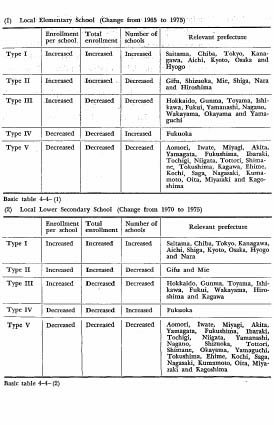| Home > Policy > White Paper, Notice, Announcement > White Paper > EDUCATIONAL STANDARDS IN JAPAN 1975 > CHAPTER4 3 | ||
Wnth regard to local elementary and lower secondary schools, classi-fication of prefectures by type of change in the enrollment per school reuniting frorrf the change in the number of students and schools is shown in the following table.

For local elementary schools, growth of enrollment per school during the last ten years in the 8 prefectures, including Saitama, Chiba, etc., coming under Type I, can be ascribed to the relatively faster increase in enrollment than in the number of schools. And the decline in enrollment per school in the 21 prefectures, including Aomori, Iwate, etc., falling under Type V, can likewise be ascribed to the relatively larger decrease in enrollment than in the number of schools.
Looking at the relationship between the change in enrollment per school in the prefectures falling under these respective types and various social and economic indicators (Cf. Referential Chart on page 373), we find that those prefectures falling under Type I are generally those where population is growing fast and heavily concentrated, while the prefectures falling under Type V are those where population is declining and far from concentrated.
For local lower wcondary schools as well, a trend similar to that of local elementary schools is evident.
| Back to Top | MEXT HOME |